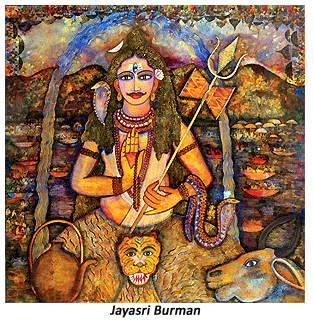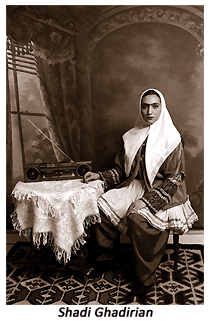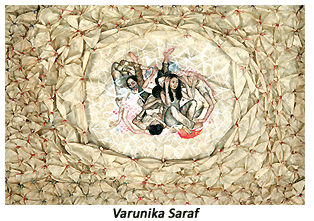- Prelude
- Editorial
- 'Public Sculptures are the Public's own Consciousness'
- Stimulating Thoughts
- Sculptural Traditions and Contemporary Art Practices
- Sculpting out a Third Dimension from Madhya Pradesh
- About Nostalgic Dragonflies and Homes in the Bags: Sculptural Snapshots from the North-East
- A Concise Chronicle of Bengal's Modern Sculpture
- Neo-sculptural Identity: Six Young Sculptors
- From Object to Experience: Notes on American Sculpture
- In the Domain of Drama Sculptures of S.Nandagopal
- Satish Gujral : Sculpting the Inner Form
- Transformation of Articulations: Mrinalini Mukherjee
- The Experiential Quotient in the Sculptures of Ravinder Reddy
- Shresta Rit Premnath A Passion for Structure
- The Anatomy of Melancholy: Sculptures of Rajesh P Subramanium
- A Crusader of/for Site Specific Public Art: Subodh Kerkar
- Installation Practices in and around Santiniketan
- A Wall is a Screen: A Promenade Film Street Performance
- Jaeger-LeCoultre An Overview
- Regency Style: Regency Furniture
- Designing the Streetscapes: Visual Elements of Pedestrian Corridors
- Sculpture Rules It All
- The Triumph of the Eternal
- Artist Index and Statistics- Anish Kapoor
- Auction Reports
- Musings from Chennai
- Art Bengaluru
- Art Events Kolkata: October-November 2010
- Mumbai Art Sighting
- An Evening of Interaction
- 6th Asian Museum Curators' Conference
- Swedish Art in India
- Couple of Difference : Recent sculptures of Karl Antao
- Previews
- In the News
- Sotheby's : Important Watches Geneva
ART news & views
Mumbai Art Sighting
Volume: 3 Issue No: 11 Month: 12 Year: 2010
November 2010
by Jasmine Shah Varma
One must raise a toast to November for having the maximum number of solo shows in the city by women artists. Jayasri Burman, Seema Kohli, Santana Gohain, Shadi Ghadirian and Varunika Saraf all had their solo shows with various galleries even as Nalini Malani's works were showcased in two other spaces as reported last month.
Not just painting
The trend to work in mediums other than what you've worked forever keeps getting amplified. Latest to bite the dust is Jayasri Burman whose solo shows was presented lavishly at Jehangir Art Gallery and later at Art Musings' premises. Fables & Folklore included for the first time Burman's sculptures besides large paintings on paper.  The sculptures were about 3-feet, 3-D manifestation of characters and icons from her paintings. The peripheral floral patterns that usually embellish her compositions on paper being done away with, the dark toned bronze sculptures of deities like Gonesh- Jononi had a more revered feel. It felt that Burman's venture into 3-D could have had a better impact. The journey from 2D to 3-D could have been more than repeating the iconography and her preoccupation seen in her paintings.
The sculptures were about 3-feet, 3-D manifestation of characters and icons from her paintings. The peripheral floral patterns that usually embellish her compositions on paper being done away with, the dark toned bronze sculptures of deities like Gonesh- Jononi had a more revered feel. It felt that Burman's venture into 3-D could have had a better impact. The journey from 2D to 3-D could have been more than repeating the iconography and her preoccupation seen in her paintings.
The paintings, the mainstay of the exhibition displayed a transition. In her trademark visual language that she has established over the years, this time she has chosen to depict certain Hindu Gods and Goddesses in a more unambiguous manner. Her earlier tapestries in ink and watercolours would generally have several characters and episodes being narrated in dream-like scenarios where floating floral patterns, ducks and other birds filled up the peripheral areas. In the latest collection one saw the story and symbolism of certain deities emphasised in an identifiable and direct way especially in works like Shrishti, Pooja, Mahadeb and Jaba-Kusum.
Burman's work is evolving in an intriguing way and one waits to see how this course would continue in the future.
Fables & Folklore concluded at Jehangir Art Gallery on October 31 and at Art Musings on November 28.
Everyday is war
Iranian photographer Shadi Ghadirian captured the presence of war and conflicts in everyday life of people in Iran through a series of photographs that represented the cold truth at The Guild Art Gallery. Select works from different series such as Qajar Series, Nil Nil, Be Colourful among others were exhibited in this first-time solo in Mumbai. The 1974 born, Tehran based photographer is known to raise concerns about Muslim women like in the well-acclaimed Qajar Series shot in 1998-2001. It is the most powerful and multi-layered black and white series among others in this show.  Ghadirian has taken studio portraits of Iranian women in hijab against the backdrop reminiscent of the 19th century Qajar dynasty drapery. But in each photograph, next to the portrayed woman, an object from the contemporary world such as a telephone instrument, a vacuum cleaner, a cassette player or a pair of a man's shoes is placed. This imagery reveals many different strands of thoughts. At one level it reveals the juxtapositions of traditions and rules of an erstwhile era that have to be carried on in the contemporary world. At another level it points at solitary women in a domestic environment left with objects and the sense of absence of the men in their lives. At another level it leads to the idea of human need to possess the material.
Ghadirian has taken studio portraits of Iranian women in hijab against the backdrop reminiscent of the 19th century Qajar dynasty drapery. But in each photograph, next to the portrayed woman, an object from the contemporary world such as a telephone instrument, a vacuum cleaner, a cassette player or a pair of a man's shoes is placed. This imagery reveals many different strands of thoughts. At one level it reveals the juxtapositions of traditions and rules of an erstwhile era that have to be carried on in the contemporary world. At another level it points at solitary women in a domestic environment left with objects and the sense of absence of the men in their lives. At another level it leads to the idea of human need to possess the material.
In the Nil Nil series, Ghadirian placed objects of military use such as a grenade, a water canteen, an ammunition belt, and a gun in the home environment. The picture of a grenade placed in a basket of fruits on a dining table is a poignant one. She drives home the same point through several scenarios. In one image a woman's pair of red stilettos is placed next to a dusty pair of man's black boots which has traces of blood on it. In another scene, a well-stocked fridge has the usual bottles, bowls of food, jars and fruits and an odd object - a military water canteen.
The presence of terror in the perfect domestic environment drives the destructive nature war in a more poignant and gut-wrenching manner. Perhaps, seeing something where it is not expected does catch one's attention better than seeing a horrific scene of war in the battlefield.
Shadi Ghadirian Solo concluded on November 30.
Sublime treat
Sanatana Gohain's solo show Unknown Change presented by The Fine Art Company was held at the Museum Gallery. Her latest works on paper and board with acrylic, pigment, graphite and dry pastels were shown here.  Firstly, when you see her works, it is hard to accept that these works are on paper. They appear opaque and solid with traces of colour, scratch-like marks and forms. You wouldn't be the only one mistaking them for rusting iron or bronze slabs. Secondly these paintings are not about the colour they are made of. She creates an entity that, if you allow, could draw you in and transport you to another place. We are bombarded with narrative, symbolic and conceptual art. Gohain's works come across as serene, like an undisturbed waterbed. Like they say still waters run deep, Gohain's paintings bring out depth and a universe. Spend enough time and you'd experience vibrations and perhaps a mystical feeling too. Once you are done with marveling the techniques she would have used to create such a rich visual experience, one comes to the question that can all visual art experiences be about tangible visual codes? Perhaps the far recesses of our minds are layered with a coding that are contour-less and ambiguous like Santana's paintings.
Firstly, when you see her works, it is hard to accept that these works are on paper. They appear opaque and solid with traces of colour, scratch-like marks and forms. You wouldn't be the only one mistaking them for rusting iron or bronze slabs. Secondly these paintings are not about the colour they are made of. She creates an entity that, if you allow, could draw you in and transport you to another place. We are bombarded with narrative, symbolic and conceptual art. Gohain's works come across as serene, like an undisturbed waterbed. Like they say still waters run deep, Gohain's paintings bring out depth and a universe. Spend enough time and you'd experience vibrations and perhaps a mystical feeling too. Once you are done with marveling the techniques she would have used to create such a rich visual experience, one comes to the question that can all visual art experiences be about tangible visual codes? Perhaps the far recesses of our minds are layered with a coding that are contour-less and ambiguous like Santana's paintings.
Unknown Change concluded on November 7.
Among other shows
Galerie Mirchandani + Steinruecke hosted Varunika Saraf's second solo show The Chair in the Cloud. The show concluded on November 27. Saraf's work process and imagery evokes intrigue. She works on rice paper and then pastes that on coloured or printed fabric.  Unlike a miniature artist who also uses rice paper, Saraf makes really large size works putting together characters and fragments of narratives, episodes from history or fantasy. The paper is painted upon, stitched and in some places she uses the tie and dye technique on paper. Her works depict an imaginary time which has elements of contemporary life as well period imagery. The visually and technically absorbing works somehow leave you questioning what exactly is the artist talking about.
Unlike a miniature artist who also uses rice paper, Saraf makes really large size works putting together characters and fragments of narratives, episodes from history or fantasy. The paper is painted upon, stitched and in some places she uses the tie and dye technique on paper. Her works depict an imaginary time which has elements of contemporary life as well period imagery. The visually and technically absorbing works somehow leave you questioning what exactly is the artist talking about.
Seema Kohli's Myth is Reality opened at the Museum Gallery on November 15th. She exhibited a series of her detailed paintings on canvas and sculptures presented by Gallery Art & Soul. The show shifted to the gallery's premises and is on view till December 5. The Delhi based painter's urban environs and age-old myths come together in her compositions to narrate stories of a mystical, imaginary land.
________________________________________________________________________________
| Corrigendum We regret having misprinted the name of Vijay Shinde as Nalini Malini for the image under Mumbai Art Sighting, in the issue November 2010, Vol 3 No 3
|